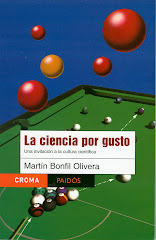by Martín Bonfil Olivera
Published on Milenio Diario, December 10, 2008
 The news that appeared in several media two weeks ago does not grab the reader's attention at first glance: it's been discovered that parasite Giardia duodenalis does in fact have nucleoli.
The news that appeared in several media two weeks ago does not grab the reader's attention at first glance: it's been discovered that parasite Giardia duodenalis does in fact have nucleoli.
It was, however, the subject of several scientific front pages. Why? Let me explain the importance of the discovery and why it is good news.
The amazing image of the cell that molecular biology has revealed to us in the last few decades shows that it is a much more complex and dynamic system than the gelatin with inserted fruits that high school students usually study. For example, the nucleolus appeared inside the nucleus as a little sphere with no well-defined function.
Today we know that it is a complex sub-cellular factory where, with great precision and speed, ribosomes are assembled, whose function is to make proteins. Since proteins are the molecules responsible of performing basically all of a cell's functions, it's clear that ribosomes, and thus nucleoli, are vital to the cell's economy. However, only cells with nucleus — called eukaryotes — have a nucleolus. Bacteria and their cousins archaea — prokaryotes — do not have nucleus nor nucleolus. In the border between the two reigns, it was thought that some "primitive" eukaryotes, like the protozoa Giardia duodenalis (also known as Giardia lamblia), a common cause of gastroenteritis in humans and other mammals, had a nucleus, but not a nucleolus.
This being said, the importance of the discovery is that it "breaks the paradigm" that there were exceptions to the rule that prokaryotes, besides a nucleus, also had nucleolus.
Furthermore, the news deserves our attention because it was a discovery done by Mexican researchers, leaded by Luis Felipe Jiménez, from the Science School at UNAM (the National Autonomous University of Mexico), together with scientists from IPN (National Polytechnical Institute) and from the Cancer and Pediatrics National Institutes (and from Zurich University). The discovery was achieved using diverse techniques of light and electronic microscopy, in which Jimenez is one of the main national experts.
As the note stated, "it was a triumph of Mexican microscopy" and another demonstration that our universities and public health institutes can do first world-quality science, that may have health applications. Good job!
To receive Science for pleasure weekly
in your email, subscribe here!





No comments:
Post a Comment